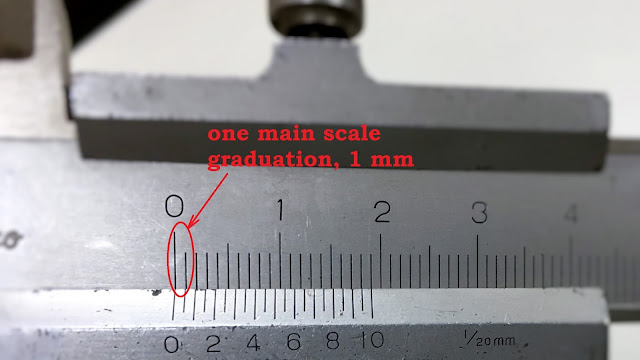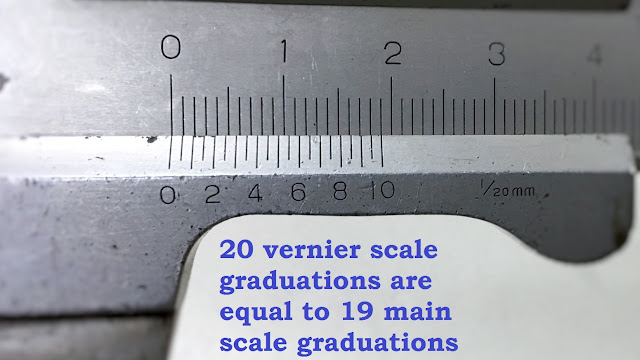The vernier caliper is one of the most commonly used measuring instruments in the industry. Let me try & explain how it works.
A Vernier with Least Count of 0.05mm (Fig.2) can measure from 0.05mm, and it's multiples, like 0.1mm, 1.15mm, 50.5mm etc.
A Vernier with Least Count of 0.02mm (Fig.3) can measure from 0.02mm, and it's multiples, like 0.12mm, 6.18mm, 45.5mm etc.
Example. 1 (refer Figs.4 & 6):
1 Main Scale Graduation(M) = 1mm
1 Vernier Scale Graduation(V) = 0.95mm
Least Count(LC) = 0.05mm
M - LC = VC
1 Vernier Scale Graduation(V) = 0.049 inches
Least Count(LC) = 0.001 inches
2(M) - LC = VC
Careful observations of Fig.8 reveals that 20 Vernier Scale Graduations(V) equal 19 Main Scale Graduations(M). Let's call the No. of Vernier Scale Graduations, n.
nV = (n-1)M
nV = nM - M
V = M - M/n
V = 1 - 1/20 (since M = 1 mm)
V = 1 - 0.05
V = 0.95 mm
Least Count(LC) = M - V
LC = 1 - 0.95
LC = 0.05 mm
The Least Count can also simply be calculated as:
LC = M/n
LC = 1/20
LC = 0.05 mm
The Least Count for the Vernier Caliper in Fig.9 (Inches) can simply be calculated as:
LC = M/n
LC = 0.025/25
LC = 0.001 Inches
Fig.1: The Vernier Caliper
Least Count:
Simply put, the least count of a vernier caliper is the minimum measurement one can measure, using that vernier. All the measurements possible on a Vernier Caliper, are multiples of it's Least Count.A Vernier with Least Count of 0.05mm (Fig.2) can measure from 0.05mm, and it's multiples, like 0.1mm, 1.15mm, 50.5mm etc.
Fig.2
A Vernier with Least Count of 0.02mm (Fig.3) can measure from 0.02mm, and it's multiples, like 0.12mm, 6.18mm, 45.5mm etc.
Fig.3
Main Scale:
The Main Scale on a Vernier Caliper is the fixed scale (refer Fig.1). It's very important to know the value of a Main Scale Graduation. Figs.4 & 5 show one main scale graduation.
Fig.4
Fig.5
Vernier Scale:
The Vernier Scale on a Vernier Caliper is the sliding scale (refer Fig.1). One Vernier Scale Graduation (Figs.6 & 7) is a fraction of One(or n) Main Scale Graduation (it is also equal to the difference between one(or n) Main Scale Graduation & the Least Count).Example. 1 (refer Figs.4 & 6):
1 Main Scale Graduation(M) = 1mm
1 Vernier Scale Graduation(V) = 0.95mm
Least Count(LC) = 0.05mm
M - LC = VC
Fig.6
Example. 2 (refer Figs.5 & 7):
1 Main Scale Graduation(M) = 0.025 inches1 Vernier Scale Graduation(V) = 0.049 inches
Least Count(LC) = 0.001 inches
2(M) - LC = VC
Fig.7
Calculating Least Count:
The Least Count of a Vernier Caliper is not necessarily marked/written on every Vernier Caliper. The user should know how to find out the Least Count, which also helps in understanding the principal behind the Vernier Caliper.
Fig.8
Careful observations of Fig.8 reveals that 20 Vernier Scale Graduations(V) equal 19 Main Scale Graduations(M). Let's call the No. of Vernier Scale Graduations, n.
nV = (n-1)M
nV = nM - M
V = M - M/n
V = 1 - 1/20 (since M = 1 mm)
V = 1 - 0.05
V = 0.95 mm
Least Count(LC) = M - V
LC = 1 - 0.95
LC = 0.05 mm
The Least Count can also simply be calculated as:
LC = M/n
LC = 1/20
LC = 0.05 mm
Fig.9
The Least Count for the Vernier Caliper in Fig.9 (Inches) can simply be calculated as:
LC = M/n
LC = 0.025/25
LC = 0.001 Inches
Working of the Vernier Caliper:
A movement equal to the Least Count or it's multiple, of the Vernier Scale, results in alignment of a Main Scale & a Vernier Scale graduation, which gives the measurement.Vernier Caliper Animated:
I've tried to show how the consecutive vernier scale graduations align with the consecutive main scale graduations, after each movement of the least count.I hope this article was helpful. Let me know if you would like me to come up with an article on a topic which interests you.
Comments and/or suggestions are most welcome.











More helpful to understand basic of Vernier Caliper
ReplyDelete